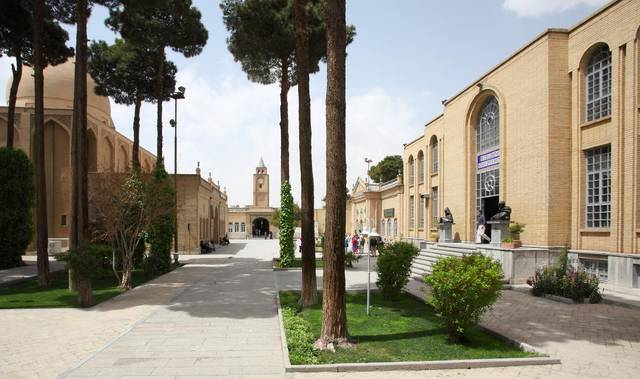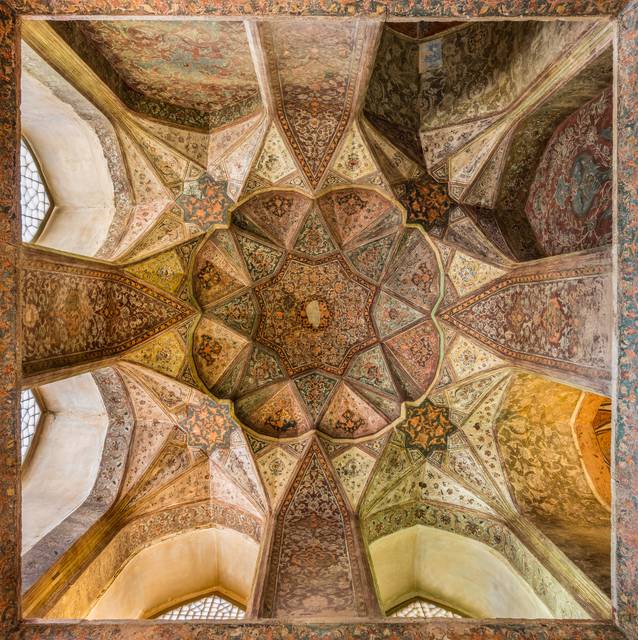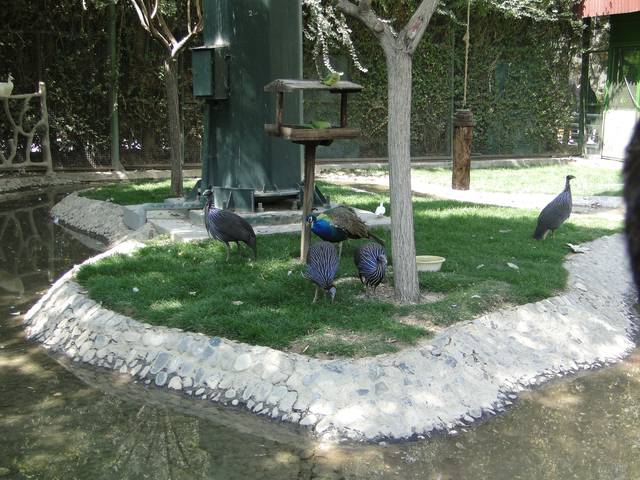
Isfahan is a city in central Iran, south of Tehran and is the capital of Isfahan Province. The Persians call it "Nesf-e-Jahan", meaning "Half The World". Due to its beautiful hand-painted tiling and magnificent public square, it is considered to be one of the most beautiful cities in the world. An ancient town and capital of Persia from 1598 to 1722, it was long noted for its fine carpets and silver filigree. Today, textile and steel mills take their place. Its architecture, tree-lined boulevards and relaxed pace make it one of the highlights of Iran.

The city is 430km south of Tehran at the foothills of the Zagros mountain range. The city enjoys a temperate climate and regular seasons. Isfahan is located on the main north-south and east-west routes crossing Iran. The city has an Armenian Quarter called Jolfa established by Shah Abbas I in the 1600s. Part of the Shah's method for controlling potentially troublesome groups out near his borders was to move large numbers of them to his capital, much as Jews were brought to Babylon in biblical times. The district was originally named New Julfa after the Armenian town of Julfa which the Shah destroyed while conquering Armenia. The Armenians were allocated land south of the river and rebuilt a prosperous community that was a key part of an Armenian trade network extending from Singapore and India to Venice and Amsterdam. Today the quarter still has many Armenian churches including a fine old cathedral, an Armenian school, shops and Armenian residents.

- Naqsh-e Jahan Square. Also known as shah square or imam square-1602 . The square contains two mosques, a palace, and the bazaar. The square is the largest historical public square in the world after Tiananmen Square in Beijing and it is a UNESCO World Heritage Site. The square is surrounded by buildings from the Safavid era. This a very popular place for locals to picnic on Friday and holiday evenings. Free.
- Chaharbagh Boulevard. 1596, dating from the Saffavid era, the avenue is the most historically famous in all of Persia. Although it's just a regular street nowadays.
- Meydan Kohne.
- Shahshahan Square.

The stunning mosques of Isfahan are among the most beautiful and interesting in the world.
- Imam Mosque, Naqsh-e Jahan Square, south side. Built during the Safavid period, it is an excellent example of Islamic architecture of Iran, and regarded as one of the masterpieces of Persian Architecture. It is registered as a UNESCO World Heritage Site. Its splendour is mainly due to the beauty of its seven-colour mosaic tiles and calligraphic inscriptions. 200,000 rials.
- Sheikh Lotf Allah Mosque, Naqsh-e Jahan Square, east side. One of the architectural masterpieces of Safavid Iranian architecture, this mosque is considered to be the most beautiful in Iran. Built in 1602 by Shah Abbas I.= and designed by his chief architect, Sheikh Bahai. The mosque was designed to be a private mosque for the royal family and therefore it does not have any minarets. There is a tunnel from the mosque to the Royal Palace, across the square. 200,000 rials.
- Masjed-e Jāmé of Isfahan, north of Naqsh-e Jahan Square in the old quarter. Started in AD842, this is the first Islamic building to adopt the four-courtyard layout of Sassanid palaces. 200,000 rials.
- Hakim Mosque, Hakim (north of Naqsh-e Jahan in the old quarter. One of the oldest mosques in Isfahan. Built by Shah Abbas II between 1656 and 1662. Located on the site of a 10th century mosque. The portal was covered in mud until it was discovered in 1956. Free.

- Ālī Qāpū. Early 17th Century. It is forty-eight meters high and there are seven floors, each accessible by a difficult spiral staircase. In the sixth floor music room, deep circular niches are found in the walls, having not only aesthetic value, but also acoustic. It is rich in naturalistic wall paintings by Reza Abbassi, the court painter of Shah Abbas I, and his pupils. There are floral, animal and bird motifs. 200,000 rials.
- Hasht Behesht Palace. 1669, reportedly built for residence purposes of the king's harem. Set within lush gardens which are free to roam if you don't want to go inside the building. Entrance to the palace building 150,000 rials.
- Chehel Sotoun Palace. 1647: It is called Palace of forty columns, as there are many columns, and in Iranian, 40 means many. Incidentally, there are twenty columns, and these are reflected in the pool in front, which might also account for its name. The function of this palace was for holding religious-national ceremonies and royal festivals and for receiving royal ambassadors and guests. It's Persian Gardens is one of nine inscribed on the UNESCO World Heritage List. Contains some spectacular battle murals. 200,000 rials.
- Talar Ashraf. 1650. Not accessible for public.
- Madreseye Sadr
- Madreseye Madar Shah . The compound was built during Soltan Hossein, a Safavid king, to serve as a theological and clerical school to train those who were interested in such sciences.The dome and the greater part of the walls are covered in bright yellow bricks which give a feeling of lightness. The entrance gate decorated with gold façade and silver, and the tile-works inside the building are masterpieces of fine art and industry. The central court, with its pool and garden, are surrounded by arcades on two levels, each giving access to a student's room.
- Madreseye Khajoo

Walk along the Zayanderud River beside the ancient bridges. You see many locals doing this everyday. However, as a result of a drought and badly planned dam, there is usually no water in the river.
- Si-o-Seh Pol. 1602. It is highly ranked as being one of the most famous examples of Safavid bridge design. Beautiful whether there is water underneath it or not, there is also a basic eatery at the northern end.
- Pol-e Shahrestan. 11th Century. It is one of the oldest surviving bridges in Iran, built in the 14th Century .
- Pol-e Khaju. 1650. It is the finest bridge in the province of Isfahan and built by the Persian Safavid king, Shah Abbas II around 1650 CE. This structure originally was ornamented with artistic tile works and paintings and served as a teahouse.
- Pol-e Joui. It is one of Isfahan's oldest bridges and was built in 1665, during the Safavid era.
- Pol-e Maarnaan.

Jolfa - The Armenian Quarter, it includes one of the most beautiful churches in Iran.
- Vank Armenian Cathedral. 17th-century Armenian cathedral. The interior is covered with fine paintings and gilded carvings and includes a wainscot of rich tile work. The delicately blue and gold painted central dome depicts the Biblical story of creation of the world and man's expulsion from Eden. 200,000 rials.
- Bedkhem Armenian Church. Another interesting combination of Persian and Armenian religious architecture, this large church completed in 1627 is full of stunning paintings and frescoes. Behind Jolfa Square, less than 5 minute walk from Vank Cathedral. 50,000 rials.

- Flowers Garden. Botanical garden. 100,000 rials.
- Birds Garden. Garden under a huge net with a lot of different birds, some locked in and some that you can walk among. 180,000 rials.
- Atashgah. A Zoroastrian fire temple. This temple is dramatically set atop a rock on the outskirts of Isfahan and provides a commanding view of the city . You can take one of the blue buses (ask at the drivers), which will take you there. 150,000 rials.
- Buqe'h-ye Ibn-Sina (Avicenna's Dome) - 12th Century.
- The Tombs of Nizam al-Mulk & Malek Shah - 12th & 18th Century.
- Sheikh Bahai Bathhouse - falling apart due to neglect.
- Pigeon Towers - Built in the 17th century to attract pigeons, whose feces were then used as fertilizer.
- Hamam-e (Bathhouse) Ali Gholi Agha
- Soffeh Mountain. Popular pick-nick spot for locals. It's possible to climb up the mountain which will take about 3 hours return. Or catch a telecabin up for 200,000 rials at the lower chairlift station.. Besides, there is a bowling underneath the telecabin station.

Note that shops in the main square must pay an additional 8% tax on sales, which is passed on to the customer. Unless the item that you are purchasing is unique or inexpensive, you may be better off shopping outside of the main square.
- For a real treasure trove, visit the famous bazaar.
- Isfahan carpets are world-famous, being the very finest of the Persian carpets. They are also often extremely expensive. Carpets from the nearby town of Na'in are similar in style, also well-known, and are expensive too. For those who are interested, it is possible to buy the highly decorative and brightly coloured traditional dress of Isfahan, but such clothing can be expensive, so it's better to haggle for a reasonable price.
- Miniatures These exquisite miniature paintings are painted on camel bone. Most of them are sold framed, and prices start from about IRR15,000. It can be more costly if the artwork is done by a miniature master. Shop and look at various shops before making your decision.
In some parks, you can simply obtain a carpet and tea from the park warden, and have a picnic on the grass! You will find families gather in these parks, and bring barbecues and cook freshly made kebabs, which smell delicious.
- Chelo kebab is a must; there are regional variations in Isfahan.
- Beryani is a popular lunch dish in Isfahan. It has made with sheep meat and lung. Although Iranians love this meal, it is very fatty. Therefore some westerners may dislike Beryani.
- Fereni (a concoction of rice flour, water and milk) at Fereni Hafez, which is along Hafez Street near Imam Square. It costs IRR3000 for a small bowl or IRR5000 for a bigger one.
Visit one of the tea-houses in the bazaar or under one of the bridges.
There are lots of coffee shops in Isfahan.
- Feel Cafe, Mir Fendereski St.. one of the most popular cafes in Isfahan.
There are various Internet cafés in Isfahan. The best place which has the fastest connection and also cheapest in the city is the Central Library of Esfahan. It is accessible from Naghshe-Jahan Square by five minutes walk.
- Russian consulate, no 11, Telephonkhane St., masjed-e sofretchi St., Chaharbagh-e Payin Ave., +98 313 222-20-60. Su-Th 08:00-13:00 & 14:00-17:00. An old consulate of Russia behind the bazzar.
You might want to have plastic money to prevent having your money stolen. Bank-e Melli-ye Iran which is a government-owned bank in Iran, provides an ATM debit card service (plastic magnetic card) for tourists who visit Iran. Tourists just need to head the nearest branch of this bank. Information on this service can be found here. Another way to prevent having your money stolen, is going to the nearest bank and getting a gift card. They are exactly like ordinary ATM debit cards, but once they get empty, they cannot be recharged. Sepah Bank or Bank -e- Sepah is a governmental bank that has a current account service for foreigners which provides both ATM debit card and cheque writing option. A list of permitted Iranian banks can be found here.

- Dasht-e-Kavir is easily reached by a 6 hours bus journey from Isfahan. You'll find oases, salt lakes, etc.
- Kashan is famous for its beautiful mansions from the 1800s and its gardens.
- Na’in is the first desert city toward east. It's a small and quiet town at the edge of desert. A perfect pattern of a desert town. Everything you like to see in a desert town you can find there.
- Qom is a holy city a few hundred kilometres away.
- Shiraz is around 6 hours south of Isfahan by bus.
- Toudeshk-Cho is 100km from Isfahan, on the way to Yazd. It is a very, quaint traditional desert village and it is easy to get to from the Jey Minibus terminal. It is well known among backpackers as the location of the Tak-Taku Homestay.
